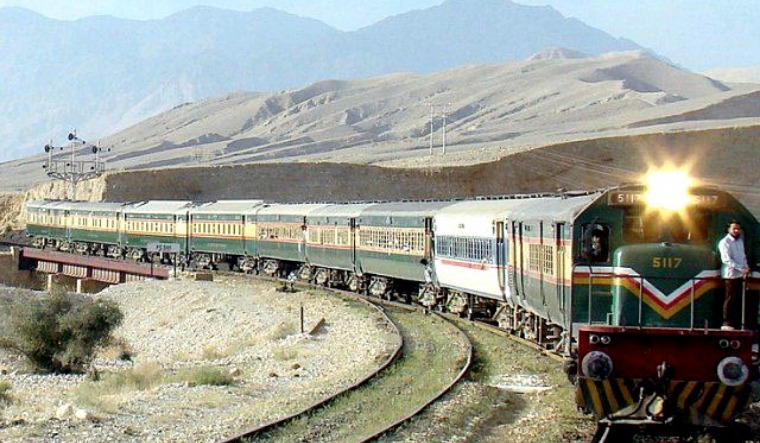Chinese President Xi Jinping has green signaled the largest Belt and Road Initiative (BRI) transport project of the railway line between Kashgar in East Turkestan (Xinjiang) to the Pakistani port of Gwadar on the Arabian Sea.
China has taken the initiative knowing the strategic importance and the far-reaching impact it will have on East-West trade and communication. The project could cost China 400 billion Yuan, equivalent to 888 tons of gold at current prices or USD 58B.
Although the idea of a railway line between Kashgar and Gwadar was there with the Chinese policy planners when the Karakoram Highway was planned, it was relegated to the back burner for some time, owing first to the COVID–19 and then due to various security issues.
The pandemic is almost overcome worldwide, though, in China, some regions are still affected. Nevertheless, Chinese authorities have found circumstances favoring a rethink of the mega project.
The proposal for this railway connectivity was assessed by scientists from the state-owned China Railway First Survey and Design Institute Group Co. Ltd. under the guidance of the institute’s deputy director of capital operations, Zhang Ling.
Why Is China Making This Huge Investment?
What prompts China to invest in such a massive project? The survey shows that the project has “the potential to reshape trade and geopolitics across the Eurasian continent and should be supported.”
No doubt, this is a remarkable project involving huge expenditure, a skilled and unskilled workforce, and the risk of loss of human lives that usually happens when a project of this size through the difficult Himalayan terrain is undertaken.
It strongly recommends coordination and collaboration between the government and financial institutions in China to raise funds for the project. Notably, the institution has been one of the largest in China and has undertaken many big railway projects.
It is not difficult to understand China’s vision of this 3,000 kilometers (1,860 miles) railway link. By reviving the Silk Route link of medieval times in its modern form, China will connect its western region with the Arabian Sea.
It means China will bypass the Strait of Malacca, thereby reducing its dependence on the South China Sea. Even in a scenario of blockade of the Strait of Malacca, China’s access to the Eurasian continent and beyond will not come to a standstill.

The railway project is part of China’s BRI. It means that China can connect to transport networks — Afghanistan, Iran, Trans-Caspi, and Turkey and onwards to European countries. Pakistan will be a special beneficiary because the nation will have easier and quicker trade with China. It will be the modern replica of the ancient Silk Road trade.
Shift In Balance Of Power Away From West
Regarding the impact on geopolitics, the infrastructure initiative will become a catalyst for shifting the balance of power away from the traditional Western-dominated trade routes. It will translate the idea of a multipolar world into a reality China has insisted on.
Rail connectivity is crucial to the development of trade and commerce, and the countries through which it passes will have a fair chance of improving the living standards of their people. Europe will have to reshape its commercial and transport strategy. It has an enormous potential for employment also.
But ultimately, it is the question of investment of extraordinary capital. Who will be bearing the cost? Two countries are involved namely China and Pakistan.
Looking back at China’s investment policy in such projects, the BRI construction projects received considerable funding from the host countries, and China’s contribution was much smaller.
For example, in the Mombasa-Nairobi US$3.8-billion standard gauge railway, China provided only 5% of the total cost, and the government of Kenya bore the remaining 95%. China contributed 30% of the US$4 billion funding for the Addis Ababa–Djibouti rail line in Ethiopia.
Similarly, China covered 75% of the Jakarta-Bandung high-speed railway’s US$5.9-billion cost, with Indonesian state-owned enterprises providing the remainder.
But Pakistan will not be able to contribute to the project in the background of its financial and economic disaster. Its Gross Domestic Product last year was US$370 billion, about six times the project’s cost.
The survey report says: “Due to energy shortage, poor investment environment, and fiscal deficits, Pakistan’s economic growth rate has been under pressure. Regarding railway investment and construction, Pakistan cannot provide sufficient financial and material support and mainly relies on Chinese enterprises for investment and construction.”
Security Question Marks Over Project In Pakistan
Apart from geologically complex terrain along the route and technical challenges to overcome in the construction and operation of the railway, the question is also of supporting infrastructure such as ports and logistics facilities almost non-available in Pakistan.
There can be other non-technical problems as well. For example, Pakistan’s labor policies could be non-static and change with the change of regimes. Pakistan politics is the real determinant of its labor policy, and Pakistan politics is manufactured in the military General HQ.

Along with that, there is the complicated policy of security deficit in Pakistan owing to the presence of strongly radicalized elements in that country, who tend to kidnap crucial persons to extract a ransom. China is already faced with opposition in Baluchistan, and the port of Gwadar has seen long strikes and shutdowns.
Chinese workers have faced terrorist attacks in Quetta and Khyber Pakhtunkhwa regions. Once China realized that Pakistan could not provide full security of life to its workers in Pakistan, it threatened to close down the projects. More than once, Pakistan had to beg excuse from the Chinese authorities for its security lapses.
It appears that China might induct its security system in Pakistan to ensure that the builders of the trans-Karakoram railway are provided security. Pakistan is said to have already handed over many of its vital infrastructural assets to China, and Beijing would not go ahead positively unless she has devised a dependable mechanism for safeguarding the lives of her workforce engaged in constructing the vital railway link.

Shaksgam Valley Challenge
Last but not least, a hindrance in the project is that the railway will pass through Shaksgam Valley, abutting Gilgit-Baltistan on the West and Ladakh in the South, which India claims is under the illegal occupation of Pakistan. The about 5,000 square miles of Shaksgam Valley were ceded to China by Pakistan, where the former has built a railway line to Lhasa.
India has been warning both Beijing and Islamabad that the entire Pakistan-occupied Kashmir, Gilgit-Baltistan, and Shaksgam Valley belongs to India, and it has the will and the strength to take it back. There is also a parliamentary resolution of 1994 to that effect.
In the final analysis, three things are clear. First, China is determined to have an overland link to Europe via crucial Asian states. The second is that Pakistan is not in a position to contribute to the proposed construction. The entire railway will be in the hands of China, and Pakistan has to remain content with the status of a vassal state.
The third and perhaps the most crucial point is that the railway line will pass through a disputed region. Once the multipolarity is established or India is admitted to the Security Council as a permanent member with veto powers, the entire political scenario in this Himalayan region will significantly change.
India must regain the territory illegally occupied by Pakistan and, after recovering it, focus on connectivity with Central Asia through the Wakhan corridor. That has to be the ultimate objective of India’s foreign policy for the Eurasian region.
- KN Pandita (Padma Shri) is the former Director of the Center of Central Asian Studies at Kashmir University. Views expressed here are of the author’s.
- Mail EurAsian Times at etdesk(at)eurasiantimes.com
- Follow EurAsian Times on Google News





